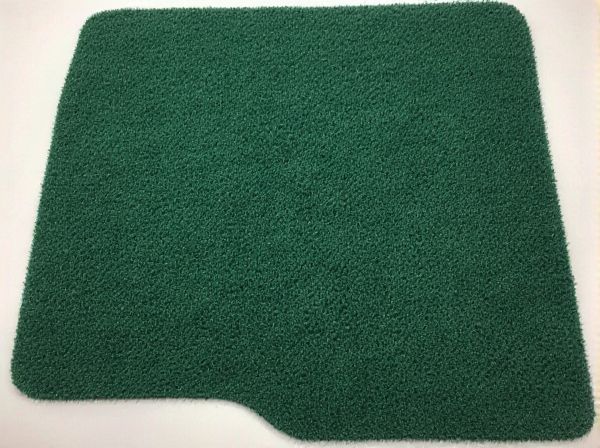
Photo illustration: Nylon Fiber vs Polyester Fiber
Nylon fiber offers superior strength, elasticity, and abrasion resistance, making it ideal for activewear and outdoor gear, while polyester fiber excels in moisture-wicking properties and quick drying, suitable for everyday clothing and home textiles. Both fibers are synthetic but differ in texture and durability, with nylon being softer and more resilient under stress. Choosing between nylon and polyester depends on your specific needs, such as durability versus moisture management.
Table of Comparison
| Feature | Nylon Fiber | Polyester Fiber |
|---|---|---|
| Durability | High abrasion resistance, long-lasting | Moderate abrasion resistance, less durable |
| Moisture Absorption | Absorbs moisture, can retain odors | Low moisture absorption, quick drying |
| Stain Resistance | Moderate resistance, requires treatment | High stain resistance, easy to clean |
| Color Fastness | Excellent, resists fading | Good, may fade faster than nylon |
| Cost | Generally higher price | More affordable option |
| Comfort | Soft texture, plush feel | Firm texture, less plush |
| Environmental Impact | Less eco-friendly, petroleum-based | Recyclable options available |
Introduction to Nylon and Polyester Fibers
Nylon fiber, a synthetic polymer first introduced in the 1930s, is renowned for its exceptional strength, elasticity, and resistance to abrasion and chemicals, making it a popular choice in textiles and industrial applications. Polyester fiber, developed in the mid-20th century, offers superior moisture-wicking properties, durability, and resistance to shrinking and stretching, widely used in apparel and home furnishings. Both fibers are petrochemical-based, but nylon typically exhibits higher tensile strength, whereas polyester excels in UV resistance and color retention.
Chemical Structure and Composition
Nylon fiber consists of long-chain polyamides composed of repeating units linked by amide bonds (-CONH-), resulting in strong hydrogen bonding that enhances tensile strength and elasticity. Polyester fiber primarily comprises polyethylene terephthalate (PET), characterized by ester functional groups (-COO-) formed through the condensation of terephthalic acid and ethylene glycol, providing high resistance to stretching and environmental degradation. The chemical structure of nylon allows for better moisture absorption and dyeing properties compared to the more hydrophobic and chemically inert polyester fiber.
Manufacturing Process Comparison
Nylon fiber manufacturing involves the polymerization of hexamethylene diamine and adipic acid, followed by extrusion through spinnerets to form filaments, then drawing to orient the molecules for strength. Polyester fiber production utilizes the polymerization of terephthalic acid and ethylene glycol, with melt spinning and subsequent drawing to enhance fiber properties. Both processes require precise temperature control and post-treatment steps, but nylon typically demands more stringent conditions due to its chemical structure and moisture absorption characteristics.
Strength and Durability Differences
Nylon fiber exhibits superior tensile strength and elasticity compared to polyester fiber, enabling it to withstand higher stress without breaking. Polyester fiber offers excellent abrasion resistance and resists stretching and shrinking, contributing to its long-lasting durability in various applications. Both fibers demonstrate strong durability, but nylon is preferred for high-stress environments, while polyester excels in maintaining shape and resistance to environmental factors like UV rays and moisture.
Moisture Absorption and Wicking Properties
Nylon fiber exhibits moderate moisture absorption, typically around 4-5%, which allows it to retain some dampness, making it less effective at moisture management compared to polyester. Polyester fiber, with its low moisture regain of about 0.4%, excels in moisture wicking and quick-drying properties, keeping fabrics dry and comfortable during physical activity. These characteristics make polyester the preferred choice for performance and activewear, while nylon is often used where durability and abrasion resistance are more critical.
Comfort and Feel on Skin
Nylon fiber offers exceptional softness and flexibility, making it comfortable and gentle against the skin, which reduces irritation during prolonged wear. Polyester fiber provides durability and moisture-wicking properties but tends to feel less breathable and can sometimes cause skin discomfort or heaviness. For sensitive skin or activities requiring maximum comfort, nylon is often preferred due to its smooth texture and lightweight feel.
Resistance to Stains and Chemicals
Nylon fiber exhibits superior resistance to abrasion and most chemicals but tends to absorb oils and stains more readily than polyester fiber, which is inherently hydrophobic and repels water-based stains effectively. Polyester fiber offers enhanced resistance to acids, alkalis, and many solvents, making it ideal for environments exposed to harsh chemicals. Both fibers resist mildew and mold, but polyester's low moisture absorption gives it an edge in stain resistance and chemical durability.
Environmental Impact and Recyclability
Nylon fiber production generates higher greenhouse gas emissions and consumes more non-renewable energy compared to polyester fiber, raising concerns about its environmental impact. Polyester fiber, derived from petrochemicals, also contributes to microplastic pollution but offers better recyclability through established recycling processes like chemical depolymerization. Both fibers present challenges in biodegradability, though advances in recycling technology aim to mitigate their ecological footprint by converting waste polyester into new textile fibers or industrial materials.
Common Applications in Industry
Nylon fiber and polyester fiber are widely utilized in the textile industry for their durability and versatility; nylon is predominantly used in activewear, hosiery, and industrial applications like ropes and conveyor belts due to its superior strength and elasticity. Polyester fiber finds extensive application in apparel, home furnishings such as upholstery and curtains, and technical textiles like filtration and geotextiles, benefiting from its wrinkle resistance and moisture-wicking properties. Both fibers are integral to automotive interiors, outdoor gear, and upholstery fabrics, where their unique characteristics meet specific performance requirements in diverse industrial sectors.
Cost Effectiveness and Market Availability
Nylon fiber generally costs more than polyester fiber due to its complex manufacturing process and higher durability, making polyester the more cost-effective choice for budget-conscious applications. Polyester fiber dominates the global market with widespread availability in various grades and forms, driven by lower production costs and extensive supply chains. Both fibers are widely used, but polyester's balance of affordability and accessibility gives it a significant market advantage.
 caratoz.com
caratoz.com